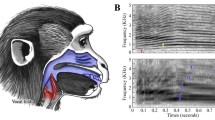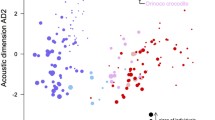Abstract
Advances in bioacoustics allow us to study the perceptual and functional relevance of individual acoustic parameters. Here, we use re-synthesised male koala bellows and a habituation–dishabituation paradigm to test the hypothesis that male koalas are sensitive to shifts in formant frequencies corresponding to the natural variation in body size between a large and small adult male. We found that males habituated to bellows, in which the formants had been shifted to simulate a large or small male displayed a significant increase in behavioural response (dishabituation) when they were presented with bellows simulating the alternate size variant. The rehabituation control, in which the behavioural response levels returned to that of the last playbacks of the habituation phase, indicates that this was not a chance increase in response levels. Our results provide clear evidence that male koalas perceive and attend to size-related formant information in their own species-specific vocalisations and suggest that formant perception is a widespread ability shared by marsupials and placental mammals, and perhaps by vertebrates more widely.



Similar content being viewed by others
References
Baru AV (1975) Discrimination of synthesized vowels [a] and [i] with varying parameters (fundamental frequency, intensity, duration and number of formants) in dog. In: Fant G, Tatham MAA (eds) Auditory analysis and perception of speech. Academic, New York, pp 91–101
Burdick CK, Miller JD (1975) Speech perception by the chinchilla: discrimination of sustained/a/and/i/. J Acoust Soc Am 58(2):415–427
Charlton BD, Reby D, McComb K (2007a) Female perception of size-related formants in red deer, Cervus elaphus. Anim Behav 74:707–714
Charlton BD, Reby D, McComb K (2007b) Female red deer prefer the roars of larger males. Biol Lett 3:382–385
Charlton BD, McComb K, Reby D (2008a) Free-ranging red deer hinds show greater attentiveness to roars with formant frequencies typical of young males. Ethology 114:1023–1031
Charlton BD, Reby D, McComb K (2008b) Effect of combined source (F0) and filter (formant) variation on red deer hind responses to male roars. J Acoust Soc Am 123(5):2936–2943
Charlton BD, Huang Y, Swaisgood RR (2009a) Vocal discrimination of potential mates by female giant pandas (Ailuropoda melanoleuca). Biol Lett 5:597–599
Charlton BD, Zhihe Z, Snyder RJ (2009b) The information content of giant panda, Ailuropoda melanoleuca, bleats: acoustic cues to sex, age and size. Anim Behav 78:893–898
Charlton BD, Zhihe Z, Snyder R (2010) Giant pandas perceive and attend to formant frequency variation in male bleats. Anim Behav 79(6):1221–1227
Charlton BD, Ellis WAH, McKinnon AJ, Brumm J, Nilsson K, Fitch WT (2011a) Perception of male caller identity in koalas (Phascolarctos cinereus): acoustic analysis and playback experiments. PLoS One 6:e20329
Charlton BD, Ellis WAH, McKinnon AJ, Cowin GJ, Brumm J, Nilsson K, Fitch WT (2011b) Cues to body size in the formant spacing of male koala (Phascolarctos cinereus) bellows: honesty in an exaggerated trait. J Exp Biol 214:3414–3422
Davies NB, Halliday T (1978) Deep croaks and fighting assessment in toads (Bufo bufo). Nature 274:683–685
Dooling RJ, Brown SD (1990) Speech-perception by budgerigars (Melopsittacus-Undulatus)—spoken vowels. Percept Psychophys 47(6):568–574
Eimas PD, Siqueland ER, Jusczyk P, Vigorito J (1971) Speech perception in infants. Science 171(3968):303–306
Ellis WAH, Bercovitch FB (2011) Body size and sexual selection in the koala. Behav Ecol Sociobiol 65(6):1229–1235
Ellis WAH, Bercovitch FB, FitzGibbon S, Roe P, Wimmer J, Melzer A, Wilson R (2011) Koala bellows and their association with the spatial dynamics of free-ranging koalas. Behav Ecol 22(2):372–377
Fant G (1960) Acoustic theory of speech production. Mouton, The Hague
Fitch WT (1997) Vocal tract length and formant frequency dispersion correlate with body size in rhesus macaques. J Acoust Soc Am 102(2):1213–1222
Fitch WT (2010) The evolution of language. Cambridge University Press, Cambridge
Fitch WT, Fritz JB (2006) Rhesus macaques spontaneously perceive formants in conspecific vocalisations. J Acoust Soc Am 120(4):2132–2141
Fitch WT, Kelley JP (2000) Perception of vocal tract resonances by whooping cranes Grus americana. Ethology 106(6):559–574
Ghazanfar A, Turesson H, Maier J, Vandinther R, Patterson RD, Logothetis N (2007) Vocal-tract resonances as indexical cues in rhesus monkeys. Curr Biol 17(5):425–430
Hardouin LA, Reby D, Bavoux C, Burneleau G, Bretagnolle V (2007) Communication of male quality in owl hoots. Am Nat 169(4):552–562
Harris TR, Fitch WT, Goldstein LM, Fashing PJ (2006) Black and white colobus monkey (Colobus guereza) roars as a source of both honest and exaggerated information about body mass. Ethology 112(9):911–920
Hienz RD, Brady JV (1988) The acquisition of vowel discriminations by nonhuman primates. J Acoust Soc Am 84(1):186–194
Hienz RD, Sachs MB, Sinnott JM (1981) Discrimination of steady-state vowels by blackbirds and pigeons. J Acoust Soc Am 70(3):699–706
Hienz RD, Aleszczyk CM, May BJ (1996) Vowel discrimination in cats: thresholds for the detection of second formant changes in the vowel. J Acoust Soc Am 100(2):1052–1058
Hienz RD, Jones AM, Weerts EM (2004) The discrimination of baboon grunt calls and human vowel sounds by baboons. J Acoust Soc Am 116(3):1692–1697
Kimmel HD (1957) Three criteria for the use of one-tailed tests. Psychol Bull 54(4):351–353
Kroodsma DE, Byers BE, Goodale E, Johnson S, Liu WC (2001) Pseudoreplication in playback experiments, revisited a decade later. Anim Behav 61:1029–1033
Lieberman P, Blumstein SE (1988) Speech physiology, speech perception, and acoustic phonetics. Cambridge University Press, Cambridge
Mitchell P (1990) Social behaviour and communication of koalas. In: Lee AK, Handasyde KA, Sanson GD (eds) Biology of the koala. Surrey Beatty, Chipping Norton, pp 151–170
Moulines E, Charpentier F (1990) Pitch synchronous waveform processing techniques for text-to-speech synthesis using diphones. Speech Commun 9:453–467
Owings DH, Morton ES (1998) Animal vocal communication: a new approach. Cambridge University Press, Cambridge
Reby D, McComb K (2003) Anatomical constraints generate honesty: acoustic cues to age and weight in the roars of red deer stags. Anim Behav 65:519–530
Reby D, Hewison M, Izquierdo M, Pepin D (2001) Red deer (Cervus elaphus) hinds discriminate between the roars of their current harem-holder stag and those of neighbouring stags. Ethology 107(10):951–959
Reby D, McComb K, Cargnelutti B, Darwin C, Fitch WT, Clutton-Brock TH (2005) Red deer stags use formants as assessment cues during intrasexual agonistic interactions. Proc R Soc Lond Ser B Biol Sci 272:941–947
Rendall D, Rodman PS, Emond RE (1996) Vocal recognition of individuals and kin in free-ranging rhesus monkeys. Anim Behav 51:1007–1015
Riede T, Fitch WT (1999) Vocal tract length and acoustics of vocalization in the domestic dog (Canis familiaris). J Exp Biol 202(20):2859–2867
Ruxton GD, Neuhauser M (2010) When should we use one-tailed hypothesis testing? Methods Ecol Evol 1(2):114–117
Sanvito S, Galimberti F, Miller EH (2007) Vocal signalling in male southern elephant seals is honest but imprecise. Anim Behav 73:287–299
Schouten JF (1940) The perception of pitch. Philips Tech Rev 5:286–294
Sinnott JM (1989) Detection and discrimination of synthetic English vowels by Old World monkeys (Cercopithecus, Macaca) and humans. J Acoust Soc Am 86(2):557–565
Sinnott JM, Kreiter NA (1991) Differential sensitivity to vowel continua in Old-World Monkeys (Macaca) and humans. J Acoust Soc Am 89(5):2421–2429
Sinnott JM, Mosteller KW (2001) A comparative assessment of speech sound discrimination in the Mongolian gerbil. J Acoust Soc Am 110(4):1729–1732
Sinnott JM, Street SL, Mosteller KW, Williamson TL (1997) Behavioral measures of vowel sensitivity in Mongolian gerbils (Meriones unguiculatus): effects of age and genetic origin. Hear Res 112(1–2):235–246
Smith M (1980) Behaviour of the koala, Phascolarctos cinereus (Goldfuss), in captivity. III. Vocalizations. Aust Wildl Res 7:13–34
Sommers MS, Moody DB, Prosen CA, Stebbins WC (1992) Formant frequency discrimination by Japanese Macaques (Macaca fuscata). J Acoust Soc Am 91(6):3499–3510
Swartz KB (1983) Species discrimination in infant pigtail macques with pictorial stimuli. Dev Psychobiol 16(3):219–231
Taylor A, Reby D (2010) The contribution of source-filter theory to mammal vocal communication research. J Zool 280(3):221–236
Taylor AM, Reby D, McComb K (2010) Size communication in domestic dog, Canis familiaris, growls. Anim Behav 79:205–210
Vannoni E, McElligott AG (2008) Low frequency groans indicate larger and more dominant fallow deer (Dama dama) males. PLoS One 3(9):e3113
von Kriegstein K, Warren JD, Ives DT, Patterson RD, Griffiths TD (2006) Processing the acoustic effect of size in speech sounds. NeuroImage 32(1):368–375
Weiss DJ, Hauser MD (2002) Perception of harmonics in the combination long call of cottontop tamarins, Saguinus oedipus. Anim Behav 64:415–426
Wiley RH (2003) Is there an ideal behavioural experiment? Anim Behav 66:585–588
Acknowledgments
We would like to thank Peter Theilemann and all the volunteers and staff at MKH for patiently allowing BC to complete the playback experiments. This work follows the Association for the study of Animal Behaviour/Animal Behaviour Society guidelines for the use of animals in research and was approved by the University of Queensland Animal Ethics Committee (approval number SAS/227/10). BC was supported by a University of Vienna startup grant and a European Research Council Advanced Grant SOMACCA (No. 230604) awarded to WTF.
Author information
Authors and Affiliations
Corresponding author
Rights and permissions
About this article
Cite this article
Charlton, B.D., Ellis, W.A.H., Larkin, R. et al. Perception of size-related formant information in male koalas (Phascolarctos cinereus). Anim Cogn 15, 999–1006 (2012). https://doi.org/10.1007/s10071-012-0527-5
Received:
Revised:
Accepted:
Published:
Issue Date:
DOI: https://doi.org/10.1007/s10071-012-0527-5




